|
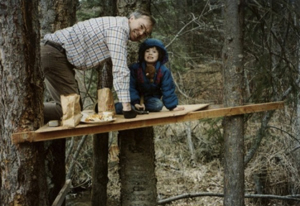
|
|
Building my first tree fort
|
Since the first time my Grandfather handed me a tool as a toddler in
his woodworking shop, I've been obsessed with making things. I spent
my entire childhood in the quest for the coolest tree fort, the
fastest go-kart, the best cane pole to fish the stream behind our
house. Though I spent most of my time working alone, looking back I
now see that everything I was ever truly passionate about had more
to do with the people and potential for relationships than the actual
finished project itself. Tree forts meant club meetups and
sleepovers, Go-karts meant races with friends, the more fish I
caught, the more people I could invite to eat.
Having fairly superficially pursued countless hobbies my whole life,
three years ago I decided it was time to finally get serious and
focus on just one thing. I don't know why I, a young woman who loves
to be with people, who cares far more about building relationships
than building furniture (or anything else for that matter), chose a
hobby and eventually a career path that has, at least for the last
40 years, largely been dominated by older men who love to work
alone, but here I am.
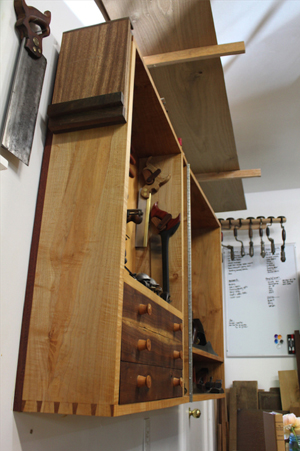
|
|
Handtool Woodwork has captured my heart
|
I didn't know any local woodworkers, and as I jumped into the rabbit
hole that is handtool woodwork, my growing passion for the craft
began to make me feel increasingly isolated from the community
around me. As I worked alone in my garage, I had no one with whom to
share my triumphs and failures, and most importantly, I didn't have
anyone to call when I got stuck. I love reading, so in my initial
excitement, I voraciously consumed 300 some woodworking related
books and blogs that first year, but unfortunately while the subject
matter interested me, I really didn't learn much. I don't possess
the ability to learn techniques by reading and following set plans
is nearly impossible for me, so when I got stuck, I was really
stuck, and ready to give up woodwork altogether.
Fortunately for me, right around that time, I discovered the growing
community of woodworkers freely sharing photos of their work, tips,
and tricks through the social media website, Instagram. Suddenly, I
had the ability to snap a picture of my problem joint or ornery tool
with my camera phone and have instant access to the help, advice and
encouragement of other knowledgeable woodworkers from around the
world. I had previously tried to join several other online
woodworking communities but was quickly disenchanted by what I
perceived to be a lack of desire to freely share and build
relationships in favor of a far more competitive atmosphere. Another
really awesome surprise that Instagram afforded me was that there are, in
fact, other women woodworkers out there, and what's more, women
HANDTOOL woodworkers. If there weren't 1000 other things I owe to
Instagram, my friendship with local handtool woodworker, Marilyn
Guthrie (check out her blog www.sheworkswood.com), is absolutely priceless.
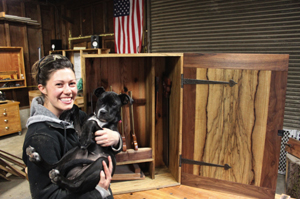
|
|
Posing with my first shop dog and my
first finished commissioned piece
|
Marilyn and I started getting together regularly to talk woodwork
and collaborate on projects soon after meeting on Instagram. She is
farther along in her woodworking journey than I, so she has been an
excellent resource for particularly tough questions. She has been
kind and generous with her time and tools. Instagram has afforded us
both the opportunity to expand our "real life" woodworking
community. She had also formerly struggled with the loneliness
associated not only with being a handtool woodworker in a sea of
tablesaws and routers, but also being the only woman she knew of in
the industry.
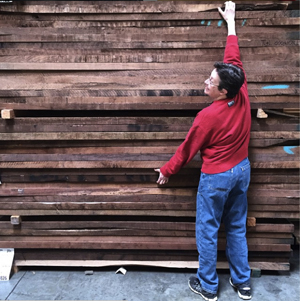
|
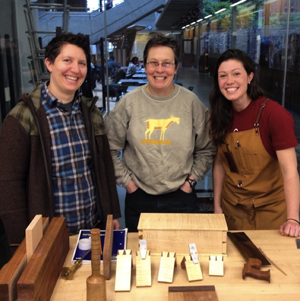
|
|
Marilyn Guthrie is awesome
|
With Kim Mcintyre and Marilyn Guthrie
at the Seattle Lie-Nielsen show
|
My conversations with Marilyn and other women woodworkers have
carried so many shockingly similar strains that an idea for a
regular written column began to ruminate in my mind. When Highland
Woodworking approached me to write for them, we all
decided their newsletter would be the perfect venue for the idea, so
please follow along, encourage all your friends (male or female) to
pick up a few quality hand tools and do the same. Each month I hope
to interview a new woman in woodwork and include a short tutorial on
an easy beginner project for those interested in delving into the
awesomely rewarding world of handtool woodwork.
To prepare for some forthcoming tutorials, I've got a bit of
homework for you- assemble a toolkit. Borrow from your friends.
Start saving some money to invest in quality tools. I'm all about
being thrifty and having the minimum toolkit to do the maximum
amount of work, and since I'm always asked by beginners looking to
take the handtool plunge, here's what I consider to be the minimum
toolkit for handtool woodwork:
Though there are many more tools that can later be added to your
toolkit, I think you will find that you will be able to get a really
good start with these tools. You can use them and then add to your
toolkit as you grow in skill and can know better where your needs
lie.
Next month in "Women in Woodworking" I sit down with
Andrea Ramsay, a woodworker who just completed the three month
handtool intensive at the Port Townsend School of Woodworking. We'll
have a few laughs and tackle the first beginner project every
woodworker should tackle - a shop made straightedge.
Anne Briggs Bohnett is a 26 year old woodworker out of Seattle, Washington. She and her husband Adam own and operate a small farm aimed at teaching youngsters about animal husbandry, traditional woodwork, and it's also where their food comes from! Anne has been seriously pursuing woodwork with a focus on handtool use for three years and is passionate about the preservation of traditional methods and skills and building community.
Anne can be reached directly via email at briggs.anne@gmail.com
and you can check out her website at www.anneofalltrades.com.
Return to
Wood News
front page
|












